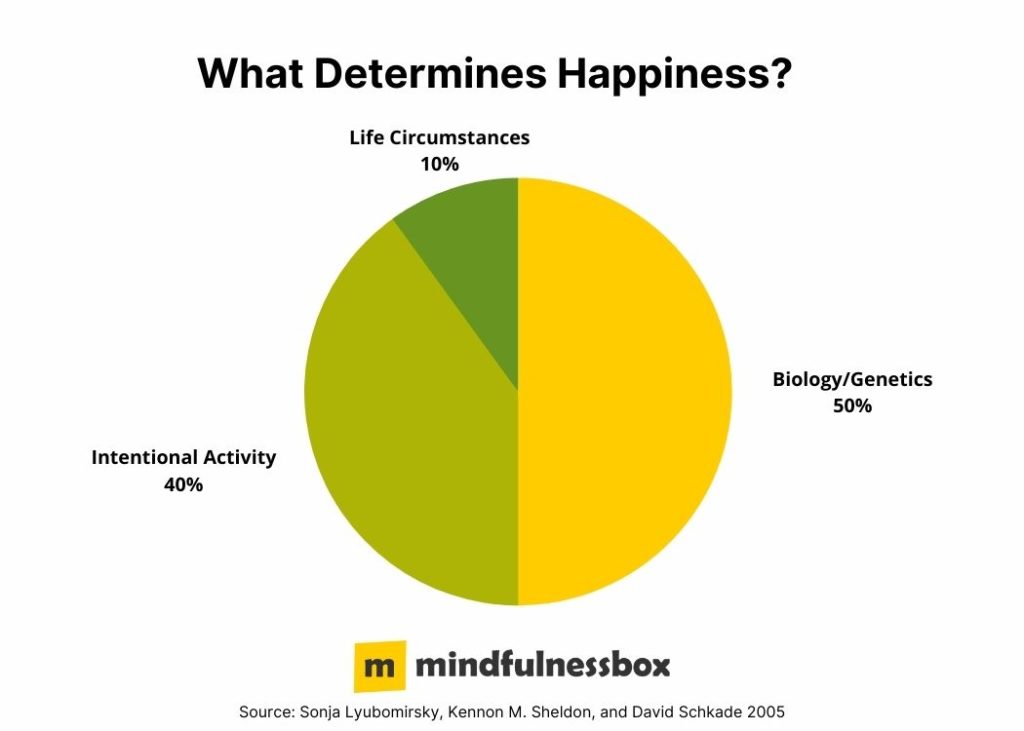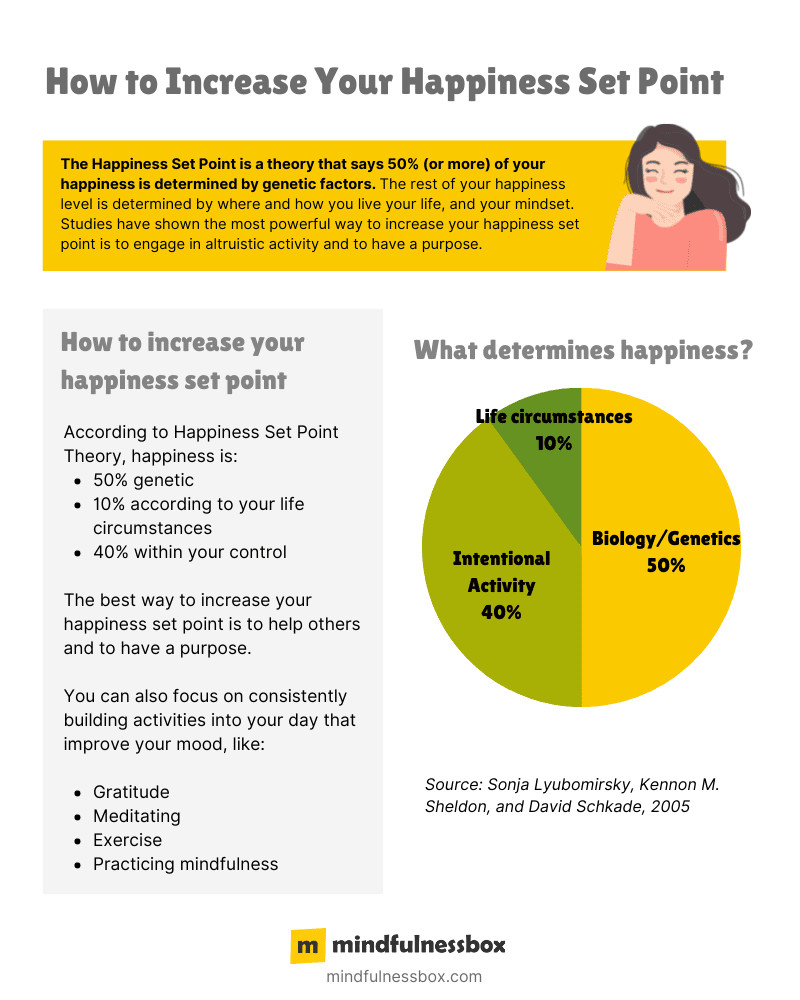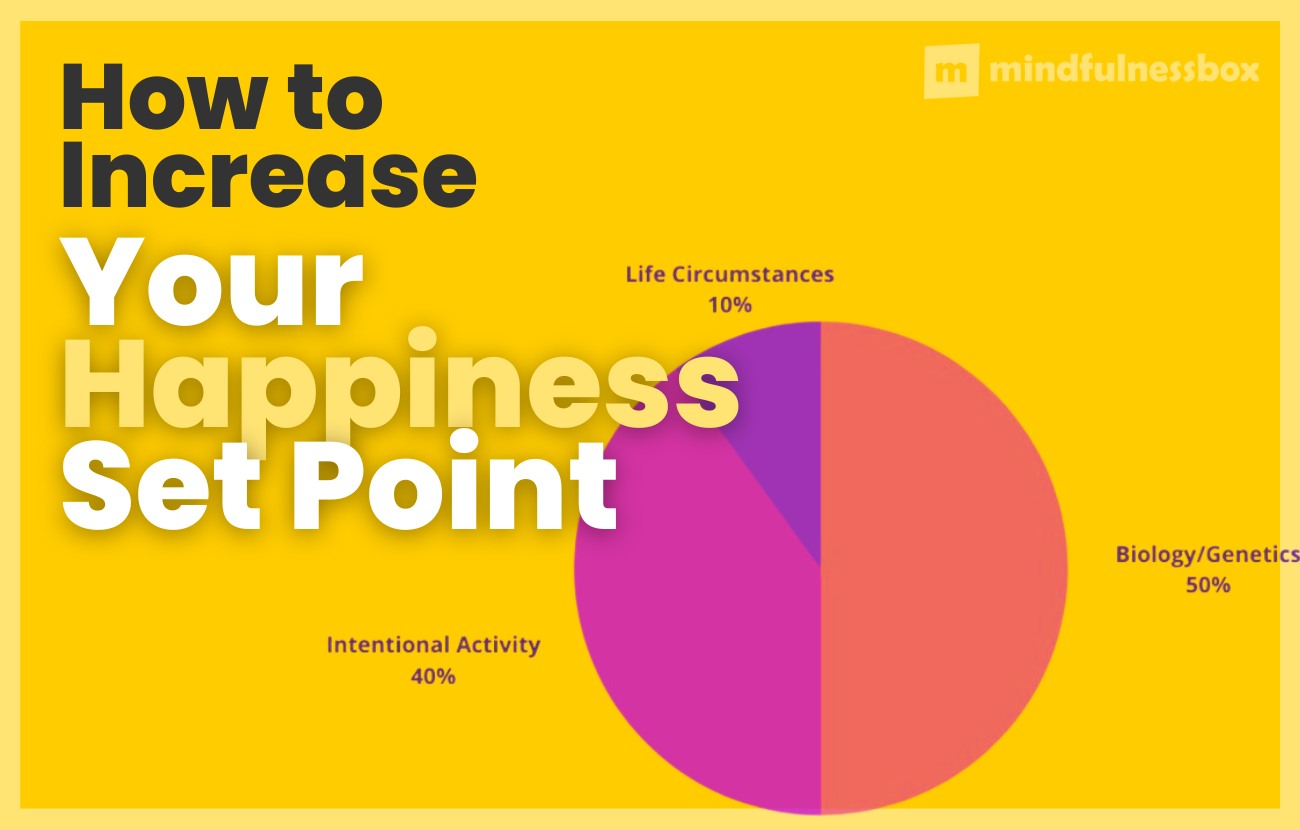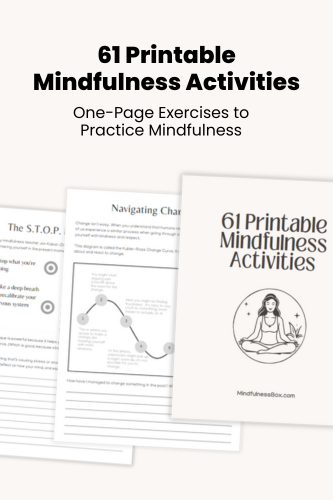Is happiness genetic? The Happiness Set Point theory that says 50% (or more) of your happiness is determined by genetic factors. The rest of your happiness level is determined by where and how you live your life, and your mindset. Studies have shown the most powerful way to increase your happiness set point is to engage in altruistic activity and to have a purpose.
A couple years ago, I read the book The Happiness Hypothesis by Jonathan Haidt.
Haidt references studies showing that 50% of our happiness is determined genetically. This concept is known as your “happiness set point.” The other 50% of your happiness is under your control.
Get dozens of one-page exercises to help practice mindfulness, meditation, gratitude, and self love. Perfect for printable handouts when teaching mindfulness to groups, students, or in the workplace.
To see examples, plus a full list of the 61 exercises included, click below.
When I became aware of this concept, I felt both frustration and relief.
Frustration because if I had a different genetic makeup, I might spend more of my time in a state of happiness.
Relief because the “set point theory of happiness” helps to counter the feeling that when I’m unhappy, there’s probably something I’m doing wrong. In reality, there could be a genetic component to what I’m experiencing that’s out of my control.
In the years since the original research that spawned the happiness set point, there has been a back-and-forth among scientists as to how much of our happiness is truly within our control.
Let’s dive into the happiness set point, and whether we might be able to influence it.
What is the happiness set point?
The happiness set point is a concept laid out by researchers Sonja Lyubomirsky, Kennon M. Sheldon, and David Schkade in a paper in 2005.
The researchers reviewed a wide range of research and concluded that happiness is 50% genetic, 10% according to your circumstances, and 40% within your control.

This theory is based around a review of existing research in the field, particularly a University of Minnesota study of 1,300 sets of identical and fraternal twins.
The study studied the sets of twins ten years apart, and found that identical twins (those that share identical genetic material) were much more likely to be at the same level of happiness.
Based on this meta-analysis of research, the approximate numbers of 50/40/10 were reached:
- 50% of your happiness is your “genetic set point”
- 40% of your happiness depends on the intentional activities you engage in and the mindset you cultivate
- 10% of your happiness depends on external life circumstances
How to increase your happiness set point

Although genetic factors are powerful, psychology researchers agree that despite strong genetic influence, we’re able to have at least some impact on our level of happiness through our mindset, activities, and life circumstances.
Studies have shown the most powerful way to do this long-term is to engage in altruistic activity and to have a purpose.
You’re also able to impact your level of happiness by cultivating a healthy mindset and positive activities.
Research-backed methods to improve your well-being include:
- Doing activities that get us into a state of flow
- Practicing gratitude
- Meditating
- Exercise
- Practice mindfulness
Critiques of the happiness set point
Over time, the simplicity of this 50/40/10 approach has attracted critiques from other researchers, and the authors of the original study have themselves walked it back, saying “Our aim was more to pose a question—is it possible for happiness to go up—and to stay up?—than to provide an answer.”
In the years since 2005, additional research has indicated that we may be able to control less of our happiness than expected.
For instance, a 2016 study contended that 20-30% of happiness may be within our control, and the rest depends on genetic factors.
Whatever the numbers are, the general theory behind the happiness set point remains: there is a portion of your well-being that is set, and there’s a portion you have influence over.
The hedonic treadmill

Another well-studied phenomenon in social science is the hedonic treadmill.
This is the idea that when good things happen to you, your mood improves for a short time before falling back to your happiness baseline.
A 1978 study looked at lottery winners and found that after the initial high of winning, they were no happier than anyone in the control group who hadn’t won the lottery.
This is even true in the reverse scenario.
The same study looked at people who had been paralyzed. Again, after allowing for a year of adjustment, the people who had been paralyzed returned to their hedonic set point (and reported, on average, greater satisfaction in their daily activities than the lottery winners).
Can you reset your happiness set point?
While you can’t reset your happiness set point entirely, you may be able to influence it.
There is an ongoing debate among researchers over how much your happiness set point is able to change over the course of your life.
According to one review of data from the German Socio-Economic Panel Survey (the longest running collection of happiness statistics in the world), there are certain life events or pursuits that can alter your baseline happiness level.
Traumatic experiences like the unexpected loss of a child, or ongoing struggles with unemployment, were found to pull the happiness set point down.
On the other hand, consistently practicing altruism seemed to lead to a permanent and sustainable increase in happiness.
Why it helps to understand your happiness set point
Research on the happiness set point is encouraging because it indicates that we have control over 20-50% of our level of happiness (depending on the studies referenced).
It’s also important to understand that we’re not in total control of our happiness.
If your friend seems to be consistently happier than you, it doesn’t necessarily mean that she’s trying harder to have a positive outlook, or that she’s managing her mental state better than you are.
It might just be that she has a higher genetic happiness set point.
So go easy on yourself, but at the same time, be encouraged.
Whether you have a naturally high level of happiness, return to a naturally low baseline, or fall somewhere in between, it can be helpful to simply acknowledge what you’re working with.
With effort over time, you can increase your level of happiness.
Further reading
For more articles on how to be happier, check out:
- How to Find Happiness Within Yourself
- How to Increase Your Vibrational Frequency
- Measuring Happiness with the Subjective Happiness Scale
- Life Is Not A Problem to Be Solved, But a Reality to Be Experienced
Frequently asked questions
What is the set point of happiness?
The set point of happiness refers to your general baseline level of happiness. Every person has a different happiness set point determined by genetic factors as well as life circumstances and intentional activities and mindset factors. If you’re mostly happy, you have a high happiness set point. If the baseline you tend to fall back to us mostly unhappy, you have a low happiness set point.

My mindfulness practice kicked off in 2016 with a ten-day silent retreat. Since then, I’ve read dozens of books about mindfulness and completed hundreds of hours of meditation. Thinking about what makes humans happy, calm, and peaceful is endlessly fascinating to me.


